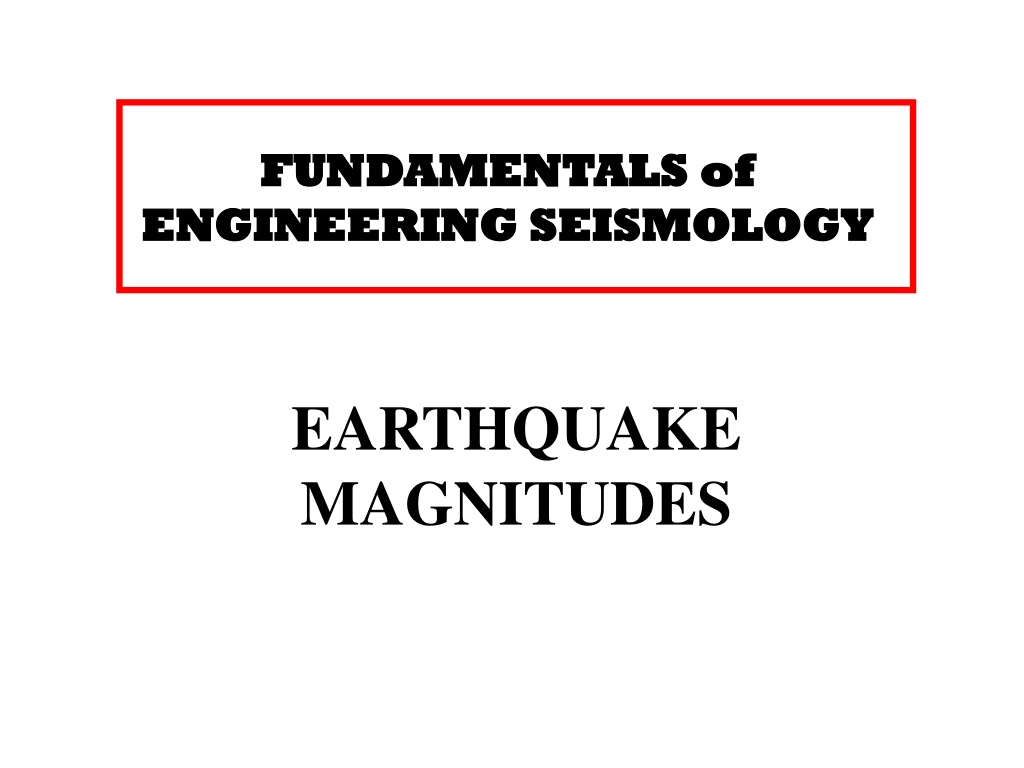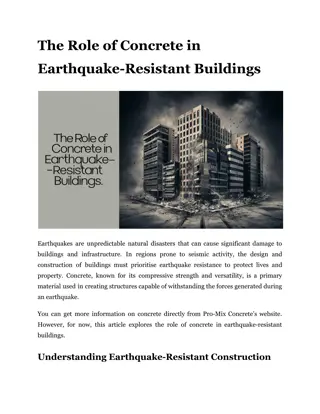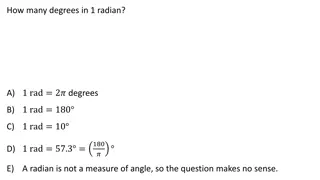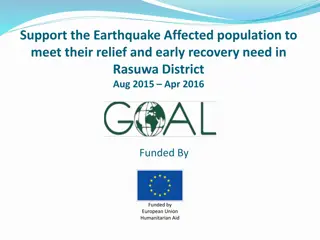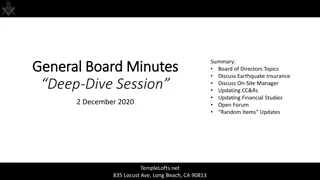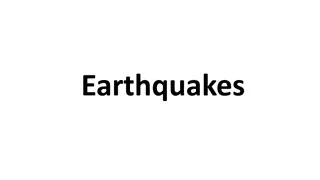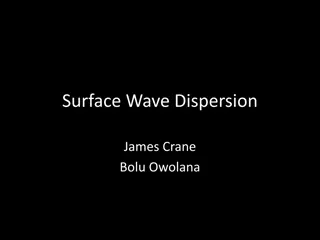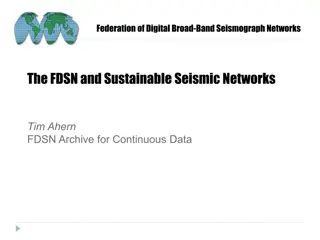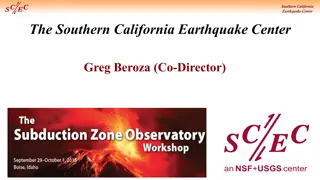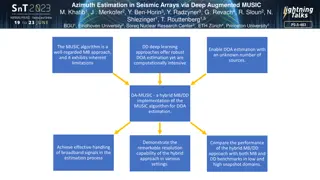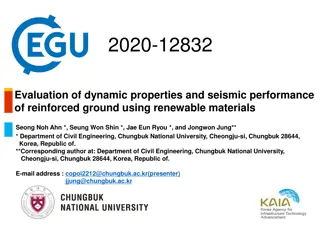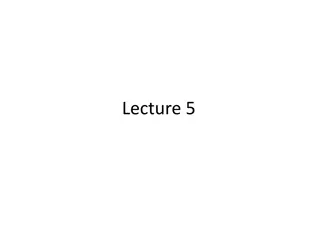Understanding Earthquake Magnitudes and Seismic Measurements
Delve into the fundamentals of engineering seismology and earthquake magnitudes, exploring topics such as fault dimensions, slip distribution, spectral shapes, Richter's observations, and logarithmic scales. Gain insights into how seismic measurements are characterized and understand the significance of peak amplitudes in seismograms. Learn about the development of magnitude scales and the logarithmic nature of earthquake measurements.
Download Presentation

Please find below an Image/Link to download the presentation.
The content on the website is provided AS IS for your information and personal use only. It may not be sold, licensed, or shared on other websites without obtaining consent from the author. Download presentation by click this link. If you encounter any issues during the download, it is possible that the publisher has removed the file from their server.
E N D
Presentation Transcript
FUNDAMENTALS of FUNDAMENTALS of ENGINEERING SEISMOLOGY ENGINEERING SEISMOLOGY EARTHQUAKE MAGNITUDES
Earthquake source characterization Magnitude Fault dimensions (covered before) Slip distribution (kinematics) Fourier transform refresher Point source representation Spectral shape Corner frequency Stress parameter
Earthquake Magnitude Earthquake magnitude scales originated because of the desire for an objective measure of earthquake size Technological advances -> seismometers
Earthquake Magnitudes In the 1930 s, Wadati in Japan and Richter in California noticed that although the peak amplitudes on seismograms from different events differed, the peak amplitudes decreased with distance in a similar manner for different quakes.
Seismogram Peak Amplitude F The peak amplitude is the size of the largest deflection from the zero line.
Richters Local Magnitude Richter used these observations to construct the first magnitude scale, ML (Richter s Local Magnitude for Southern California). He based his formula for calculating the magnitude on the astronomical brightness scale - which was logarithmic.
Logarithmic Scales In a logarithmic scale such as magnitude A change in one magnitude unit means a change of a factor of 10 in the amplitude of ground shaking (wait! This is an often used statement, but it is too simplistic, and I hope you will know why by the end of the course).
The proper statement In a logarithmic scale such as magnitude: A change in one magnitude unit means a change of a factor of 10 in the amplitude of motion that defines the magnitude. This could be the response of a particular type of instrument, or it could be ground motions at very long periods or ground motions at periods near 1 sec, etc. For peak ground motions and response spectra, the scaling is usually less than 10M/2 where M is the moment magnitude, defined shortly, rather than 10M.
Richters Magnitude Scale Defined for specific attenuation conditions valid for southern California Only valid for one specific type of seismometer Can be used elsewhere if local attenuation correction is used and simulated Wood-Anderson response is computed Not often used now, although it IS a measure of ground shaking at frequencies of engineering interest
Richter tied his formula to a specific instrument, the Wood-Anderson torsion seismograph He assumed a reference motion at a reference distance. To compute the magnitude at different distances, he calibrated the attenuation function
Richter fixed the scale assuming that a ML=3 earthquake produces 1mm of maximum amplitude on a Wood-Anderson seismometer at 100 km Ml=Log Amax-Log A0 -logA0 changes from region to region. The calibration of a local magnitude scale for a given region implies the determination of the empirical attenuation correction for that region (and the magnitude station corrections) The W-A seismometers are not still used. The W-A recording is computed numerically (by convolving the ground displacement with the W-A transfer function)
In many studies, the attenuation function is determined by a parametric approach = + + log( / ) ( ) LogA n R R k R R M 0 ref ref ref where the reference distance and the reference magnitude are fixed In agreement with the Richter scale.
In contrast to the general magnitude formula, ML considers only the maximum displacement amplitudes but not their periods. Reason: WA instruments are short- period and their traditional analog recorders had a limited paper speed. Proper reading of the period of high-frequency waves from local events was rather difficult. It was assumed, therefore, that the maximum amplitude phase (which in the case of local events generally corresponds to Sg, Lg or Rg) always had roughly the same dominant period. The smallest events recorded in local microearthquake studies have negative values of ML while the largest ML is about 7 , i.e., the ML scale also suffers saturation (see later). Despite these limitations, ML estimates of earthquake size are relevant for earthquake engineers and risk assessment since they are closely related to earthquake damage. The main reason is that many structures have natural periods close to that of the WA seismometer (0.8s) or are within the range of its pass-band (about 0.1 - 1 s). A review of the development and use of the Richter scale for determining earthquake source parameters is given by Boore (1989). From the IASPEI New Manual Seismological Observatory Practice
Modern Seismic Magnitudes Today seismologists use different seismic waves to compute magnitudes These waves generally have lower frequencies than those used by Richter These waves are generally recorded at distances of 1000s of kilometers instead of the 100s of kilometers for the Richter scale (this is important because most earthquakes occur in remote places, such as under the oceans, without instruments within 100s of kilometers)
Teleseismic MS and mb Two commonly used modern magnitude scales are: MS, Surface-wave magnitude (Rayleigh Wave) mb, Body-wave magnitude (P-wave)
Surface wave magnitude Work started by Gutenberg developed a magnitude scale based on surface wave recordings at teleseismic distances. The measure of amplitude is the maximum velocity (A/T)max. This allowed not only to link the scale to the energy, but also to account for the large variability of periods T corresponding to the maximum amplitude of surface waves, depending on distance and crustal structure. Collaboration between research teams in Prague, Moscow and Sofia resulted in the proposal of a new Ms scale and calibration function, termed Moscow- Prague formula, by Karnik et al. (1962): A A = + = . 1 + 3 . 3 + log ( ) log 66 log Ms s T T max max for epicentral distances 2 < < 160 and source depth h < 50 km. The IASPEI Committee on Magnitudes recommended at its Z rich meeting in 1967 the use of this formula as standard for Ms determination for shallow seismic events (h 50 km) Note: also Ms suffers of saturation (see later )
Body wave magnitude Gutenberg (1945b and c) developed a magnitude relationship for teleseismic body waves such as P, PP and S in the period range 0.5 s to 12 s. It is based on theoretical amplitude calculations corrected for geometric spreading and (only distance-dependent!) attenuation and then adjusted to empirical observations from shallow and deep- focus earthquakes, mostly in intermediate-period records: mB = log (A/T)max+ Q( , h) Gutenberg and Richter (1956a) published a table with Q( ) values for P-, PP- and S-wave observations in vertical (V=Z) and horizontal (H) components for shallow shocks, complemented by diagrams Q( , h) for PV, PPV and SH which enable also magnitude determinations for intermediate and deep earthquakes. These calibration functions are correct when ground displacement amplitudes are measured in intermediate-period records and given in micrometers (1 m = 10-6 m).
Later, with the introduction of the WWSSN short-period 1s-seismometers (see Fig. 3.11, type A2) it became common practice at the NEIC to use the calibration function Q( , h) for short-period PV only. In addition, it was recommended that the largest amplitude be taken within the first few cycles (see Willmore, 1979) instead of measuring the maximum amplitude in the whole P-wave train. One should be aware that this practice was due to the focused interest on discriminating between earthquakes and underground nuclear explosions. The resulting short-period mb values strongly underestimated the body-wave magnitudes for mB > 5 and, as a consequence, overestimated the annual frequency of small earthquakes in the magnitude range of kt-explosions. Also, mb saturated much earlier than the original Gutenberg-Richter mB for intermediate- period body waves or Ms for long-period surface waves Therefore, the IASPEI Commission on Practice issued a revised recommendation in 1978 according to which the maximum P-wave amplitude for earthquakes of small to medium size should be measured within 20 s from the time of the first onset and for very large earthquakes even up to 60 s (see Willmore, 1979, p. 85). This somewhat reduced the discrepancy between mB and mb but in any event both are differently scaled to Ms and the short-period mb necessarily saturates earlier than medium-period mB.
However, some of the national and international agencies have only much later or not even now changed their practice of measuring (A/T)max for mb determination in a very limited time-window, e.g., the International Data Centre for the monitoring of the CTBTO still uses a time window of only 6 s (5.5s after the P onset), regardless of the event size.
The modern standard magnitude measure: MOMENT MAGNITUDE It is defined in terms of seismic moment, M , by the equation: 0 2log 3 M 10.7 M 0 Seismic moment can be measured from seismograms or calculated by the defining equation M SA 0 Where is the modulus of rigidity in the vicinity of the source, S is average slip over the ruptured area A of the fault. 24
Why is it called moment? Radiation from a shear dislocation with slip S over area A in material with rigidity is identical to that from a double couple with strength UA (units stress*displacement*area, but stress = force/area, so units = force*displacement = a couple = work = energy) 25
Nomenclature Mw Defined by Kanamori as an energy magnitude (includes a parameter in addition to moment), but he clearly had in mind the present mapping of moment and magnitude but setting the additional parameter to a constant value M The first explicit mapping of moment (M0) and moment magnitude (M) Today people by-and-large use Mw (can write it in email); only purists such as DMB use M.
What is the proper equation? M = 2/3 log M0 10.7? M = 2/3 log M0 10.73 ? The former is correct, it corresponds to Log M0 = 1.5M + 16.05 (not 16.0 or 16.1) Hanks (personal commun.) chose 16.05 to average relations with constant terms of 16.0 and 16.1
Why use moment magnitude? It is the best single measure of overall earthquake size It does not saturate (discussed later) It can be estimated from geological observations It can be estimated from paleoseismology studies It can be tied to plate motions and recurrence relations
Empirical relations can be used to estimate moment magnitude based on size of felt area eg. Johnston et al., 1996 relations for mid- plate areas
Moment Magnitude is the Best Measure of Earthquake Size Quake 1906 San Francisco 1960 Chile Ms M 8.3 8.3 7.8 9.5
Moment Physical units (dyne-cm) 1026: Northridge, 1994 1030: Sumatra, 2004 Big range! No saturation: bigger rupture bigger moment 31 the big one USGS - SUSAN HOUGH
The Largest Earthquakes M is the appropriate choice for comparing the largest events, it does not saturate. 1960 Chile 9.5 2004 Sumatra 9.3 1964 Alaska 9.2 1952 Kamchatka 9.1 1965 Aleutians 9.0 (This pie chart needs to be revised to include the 2004 Sumatra earthquake, but the chart serves to emphasize that 0.1 M units corresponds to a factor of 1.4 increase in moment.)
ORDERS OF MAGNITUDE Fault width Why are the largest earthquakes along subduction zones? For crustal earthquakes the width is limited by the thickness of the superficial crust brittle layer (~20 km). The thickness of the brittle layer is controlled by temperature, which increases with depth Width is often considered smaller than the length even for small earthquake
ORDERS OF MAGNITUDE Fault width surface brittle 20 km plastic
ORDERS OF MAGNITUDE Fault width surface faults brittle 20 km plastic
ORDERS OF MAGNITUDE Fault width surface faults brittle 20 km plastic
Converting between magnitude scales: Empirical relations (or sometimes theoretical relations) can be used to convert between magnitude scales. This is important in deriving magnitude recurrence statistics for a region or source zone, as all magnitudes should be first reported on the same scale before characterizing their statistics
Surface wave magnitude is a close approximation to Moment M for Ms 6 to 8 events
Body-wave magnitude is not a good measure of moment M, especially for large events
Relations between magnitude scales Ms(Ekstrom) Ms(Ambraseys et al., 1996) ML(Hutton and Boore, 1984) mbLg (Atkinson and Boore, 1987) MS mbLg ML 8 Time: 20:51:43 Date: 2003-09-05; Other Magnitude File: C:\metu_03\regress\MLMSMN_M.draw; 6 4 4 6 8 Moment Magnitude
Magnitude Discrepancies Ideally, you want the same value of magnitude for any one earthquake from each scale you develop, i.e. MS = mb = ML = M But this does not always happen: San Francisco 1906: MS = 8.3, M = 7.8 Chile 1960: MS = 8.3, M = 9.6
Why Dont Magnitude Scales Agree? Simplest Answer: Earthquakes are complicated physical phenomena that are not well described by a single number. Can a thunderstorm be well described by one number ? (No. It takes wind speed, rainfall, lightning strikes, spatial area, etc.)
Why Dont Magnitude Scales Agree? More Complicated Answers: The distance correction for amplitudes depends on geology. Deep earthquakes do not generate large surface waves - MS is biased low for deep earthquakes. Some earthquakes last longer than others, even though the peak amplitude is the same. Variations in stress release along fault, for same moment. Not all earthquakes are self similar (that is, the relative radiation at different frequencies can differ--- examples: 1999 Chi-Chi compared to standard California earthquake).
Why Dont Magnitude Scales Agree? Most complicated reason: Magnitude scales saturate This means there is an upper limit to magnitude no matter how large the earthquake is For instance Ms (surface wavemagnitude) seldom gets above 8.2-8.3
Example: mbSaturation F mb seldom gives values above 6.7 - it saturates . F mb must be measured in the first 5 seconds - that s the (old) rule.
What Causes Saturation? The rupture process. Small earthquakes rupture small areas and are relatively depleted in long-period signals. Large earthquakes rupture large areas and are rich in long-period motions (we ll study this later, when we discuss source scaling)
What Causes Saturation? The relative size of the fault and the wavelength of the motion used to determine the magnitude is a key part of the explanation. Small fault compared to the wavelength: the magnitude will be a good measure of overall earthquake size. Large fault compared to the wavelength: the magnitude will be determined by radiation from only a portion of the fault, and the magnitude will not be a good measure of overall fault size 47
Relations between Magnitude Scales Note saturation 49
Are mb and Ms still useful? YES! Many (most) earthquakes are small enough that saturation does not occur Empirical relations between energy release and mb and Ms exist The ratio of mb to Ms canindicate whether a given seismogram is from an earthquake or a nuclear explosion (verification seismology)
